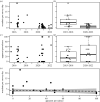Density independent decline from an environmentally transmitted parasite
- PMID: 37607579
- PMCID: PMC10444343
- DOI: 10.1098/rsbl.2023.0169
Density independent decline from an environmentally transmitted parasite
Abstract
Invasive environmentally transmitted parasites have the potential to cause declines in host populations independent of host density, but this is rarely characterized in naturally occurring populations. We investigated (1) epidemiological features of a declining bare-nosed wombat (Vombatus ursinus) population in central Tasmania owing to a sarcoptic mange (agent Sarcoptes scabiei) outbreak, and (2) reviewed all longitudinal wombat-mange studies to improve our understanding of when host population declines may occur. Over a 7-year period, the wombat population declined 80% (95% CI 77-86%) and experienced a 55% range contraction. The average apparent prevalence of mange was high 27% (95% CI 21-34), increased slightly over our study period, and the population decline continued unabated, independent of declining host abundance. Combined with other longitudinal studies, our research indicated wombat populations may be at risk of decline when apparent prevalence exceeds 25%. This empirical study supports the capacity of environmentally transmitted parasites to cause density independent host population declines and suggests prevalence limits may be an indicator of impending decline-causing epizootics in bare-nosed wombats. This research is the first to test effects of density in mange epizootics where transmission is environmental and may provide a guide for when apparent prevalence indicates a local conservation threat.
Keywords: Sarcoptes scabiei; Vombatus ursinus; bare-nosed wombat; density dependence; environmental transmission; frequency dependent transmission.
Conflict of interest statement
The authors declare no conflicts of interest.
Figures


Similar articles
-
Host, environment, and anthropogenic factors drive landscape dynamics of an environmentally transmitted pathogen: Sarcoptic mange in the bare-nosed wombat.J Anim Ecol. 2023 Sep;92(9):1786-1801. doi: 10.1111/1365-2656.13960. Epub 2023 May 23. J Anim Ecol. 2023. PMID: 37221666
-
Fine-Scale Landscape Epidemiology: Sarcoptic Mange in Bare-Nosed Wombats (Vombatus ursinus).Transbound Emerg Dis. 2023 Mar 4;2023:2955321. doi: 10.1155/2023/2955321. eCollection 2023. Transbound Emerg Dis. 2023. PMID: 40303715 Free PMC article.
-
Fluralaner as a novel treatment for sarcoptic mange in the bare-nosed wombat (Vombatus ursinus): safety, pharmacokinetics, efficacy and practicable use.Parasit Vectors. 2021 Jan 6;14(1):18. doi: 10.1186/s13071-020-04500-9. Parasit Vectors. 2021. PMID: 33407820 Free PMC article.
-
Sarcoptic mange in wombats-A review and future research directions.Transbound Emerg Dis. 2018 Apr;65(2):399-407. doi: 10.1111/tbed.12770. Epub 2017 Nov 18. Transbound Emerg Dis. 2018. PMID: 29150905 Review.
-
The emergence of sarcoptic mange in Australian wildlife: an unresolved debate.Parasit Vectors. 2016 Jun 2;9(1):316. doi: 10.1186/s13071-016-1578-2. Parasit Vectors. 2016. PMID: 27255333 Free PMC article. Review.
Cited by
-
Pollinator behaviour and prevalence of the anther smut Antherospora vindobonensis in its host, the Hungarian two-leaf squill (Scilla vindobonensis).Bot Stud. 2024 Sep 29;65(1):29. doi: 10.1186/s40529-024-00437-9. Bot Stud. 2024. PMID: 39342517 Free PMC article.
-
Non-specific markers of inflammation in bare-nosed wombats (Vombatus ursinus) with sarcoptic mange.Front Vet Sci. 2024 Jun 26;11:1403221. doi: 10.3389/fvets.2024.1403221. eCollection 2024. Front Vet Sci. 2024. PMID: 39005722 Free PMC article.
-
Assessment of the in vitro acaricidal activity of Bravecto® (fluralaner) and a proposed orange oil-based formulation vehicle for the treatment of Sarcoptes scabiei.Parasit Vectors. 2024 Apr 25;17(1):194. doi: 10.1186/s13071-024-06275-9. Parasit Vectors. 2024. PMID: 38664829 Free PMC article.
References
-
- Keeling MJ, Rohani P. 2008. Modeling infectious diseases in humans and animals. Princeton, NJ: Princeton University Press.
-
- Hoyt JR, et al. 2023. Reducing environmentally mediated transmission to moderate impacts of an emerging wildlife disease. J. Appl. Ecol. 60, 923-933. (10.1111/1365-2664.14371) - DOI
-
- Ryder JJ, Miller MR, White A, Knell RJ, Boots M. 2007. Host–parasite population dynamics under combined frequency- and density-dependent transmission. Oikos 116, 2017-2026. (10.1111/j.2007.0030-1299.15863.x) - DOI
Publication types
MeSH terms
Associated data
LinkOut - more resources
Full Text Sources

